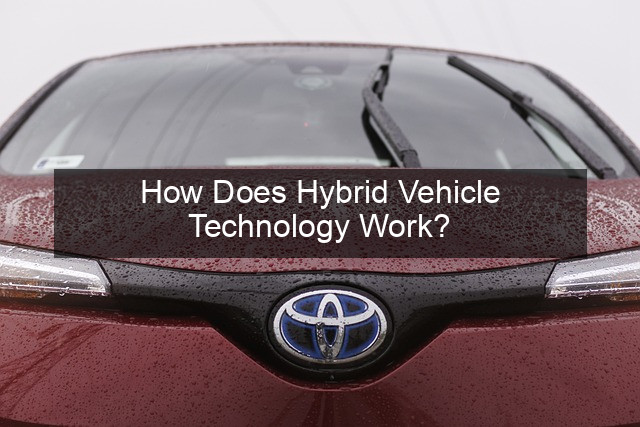How Does Hybrid Vehicle Technology Work?

- How Does Hybrid Vehicle Technology Work?
- How Does Hybrid Vehicle Technology Work?
- Types of Hybrid Vehicles
- Series Hybrids
- Parallel Hybrids
- Plug-in Hybrids
- Key Components of a Hybrid Vehicle System
- Electric Motor
- Battery Pack
- Power Control Unit
- Regenerative Braking: Recapturing Energy
- How it Works
- Benefits for Efficiency
- The Future of Hybrid Vehicle Technology
- Advancements in Battery Technology
- Integration with Other Technologies
- Conclusion
- Frequently Asked Questions (FAQ)

How Does Hybrid Vehicle Technology Work?
The automotive world is in constant flux, driven by the need for greater fuel efficiency and reduced emissions. At the forefront of this change is hybrid vehicle technology, a sophisticated blend of traditional gasoline engines and electric motors. Hybrids offer a compelling bridge between conventional vehicles and fully electric cars, providing improved mileage without the range anxiety associated with pure EVs. But how exactly do these marvels of engineering work? This article delves into the intricacies of hybrid systems, exploring the different types, their advantages, and their role in shaping a greener future for transportation. From the regenerative braking systems that recapture energy to the complex interplay between the combustion engine and electric motor, we’ll uncover the secrets behind hybrid vehicle operation. Understanding this technology is crucial for making informed decisions about your next vehicle purchase and appreciating the innovative solutions driving the automotive industry forward.
Types of Hybrid Vehicles
Series Hybrids
Series hybrids, also known as range-extended electric vehicles, utilize the electric motor exclusively for propulsion. The gasoline engine acts as a generator, charging the battery that powers the motor. This setup allows for optimal electric motor operation, leading to high efficiency in city driving. However, series hybrids are less efficient at higher speeds, where the gasoline engine’s energy conversion process becomes less effective.
These vehicles are ideal for short commutes and urban environments where stop-and-go traffic is prevalent. The electric motor provides instant torque, making for a smooth and responsive driving experience. While the gasoline engine extends the range, the primary driving force always comes from the electric motor.
Examples of series hybrids include some early models of extended-range electric vehicles. While less common than parallel hybrids, they offer a unique approach to maximizing electric driving benefits.
Parallel Hybrids
Parallel hybrids represent the most common type of hybrid vehicle on the road today. In this configuration, both the gasoline engine and the electric motor can power the wheels independently or in conjunction. This flexibility allows the system to optimize power delivery based on driving conditions.
At low speeds, the electric motor can propel the vehicle alone, offering silent and emission-free driving. At higher speeds or under heavy acceleration, the gasoline engine kicks in to provide additional power. This synergistic approach maximizes efficiency across a wider range of driving scenarios.
Many popular hybrid models on the market utilize parallel hybrid systems, demonstrating their effectiveness in balancing performance and fuel economy.
Plug-in Hybrids
Plug-in hybrid electric vehicles (PHEVs) combine the benefits of both parallel hybrids and fully electric vehicles. Like parallel hybrids, they use both a gasoline engine and an electric motor. However, PHEVs also have larger battery packs that can be charged from an external power source.
This larger battery capacity allows PHEVs to operate in all-electric mode for extended distances, often covering typical daily commutes without using any gasoline. Once the battery is depleted, the vehicle seamlessly switches to its hybrid operating mode, utilizing both the engine and motor as needed.
PHEVs offer a compelling option for drivers seeking to maximize electric driving while retaining the flexibility of a gasoline engine for longer trips.
Key Components of a Hybrid Vehicle System
Electric Motor
The electric motor is a crucial element of any hybrid system. It provides power to the wheels, either independently or in conjunction with the gasoline engine. Electric motors offer instant torque, contributing to the quick acceleration often experienced in hybrid vehicles.
These motors operate on electricity supplied by the hybrid’s battery pack. They are designed for high efficiency and can also act as generators during regenerative braking, further enhancing the vehicle’s overall efficiency.
The size and power output of the electric motor vary depending on the specific hybrid system and the vehicle’s design.
Battery Pack
The battery pack stores the electrical energy used to power the electric motor. In hybrid vehicles, these batteries are typically nickel-metal hydride (NiMH) or lithium-ion (Li-ion) batteries, with Li-ion becoming increasingly common due to their higher energy density and lighter weight.
The battery pack is charged through regenerative braking and, in the case of plug-in hybrids, through an external power source. The capacity of the battery pack directly impacts the vehicle’s all-electric range.
Battery technology continues to advance, leading to improvements in energy density, charging times, and overall lifespan.
Power Control Unit
The power control unit acts as the brain of the hybrid system, seamlessly coordinating the operation of the gasoline engine and electric motor. It monitors various parameters, such as vehicle speed, battery charge level, and driver input, to determine the optimal power source for any given situation.
This sophisticated control system ensures that the hybrid system operates efficiently and provides a smooth driving experience. It constantly adjusts the power flow between the engine, motor, and battery to maximize fuel economy and performance.
The power control unit is a complex piece of technology that is essential for the seamless integration of the hybrid system’s components.
Regenerative Braking: Recapturing Energy
How it Works
Regenerative braking is a key feature of hybrid vehicles that helps to improve fuel efficiency. When the driver applies the brakes, the electric motor acts as a generator, converting the kinetic energy of the slowing vehicle back into electrical energy. This captured energy is then used to recharge the battery pack.
This process effectively captures energy that would otherwise be lost as heat in traditional braking systems. By recharging the battery, regenerative braking reduces the load on the gasoline engine and extends the vehicle’s electric driving range.
The effectiveness of regenerative braking is most pronounced in stop-and-go traffic, where frequent braking opportunities allow for significant energy recapture.
Benefits for Efficiency
The primary benefit of regenerative braking is improved fuel efficiency. By recapturing energy during braking, the hybrid system reduces the reliance on the gasoline engine, leading to lower fuel consumption.
This efficiency gain is particularly noticeable in urban driving conditions, where frequent braking provides ample opportunities for energy regeneration. In highway driving, the benefits are less pronounced, as braking occurs less frequently.
Regenerative braking contributes significantly to the overall efficiency advantage of hybrid vehicles compared to their conventional counterparts.
The Future of Hybrid Vehicle Technology
Advancements in Battery Technology
Ongoing advancements in battery technology are playing a crucial role in shaping the future of hybrid vehicles. Researchers are constantly working to improve battery energy density, allowing for greater all-electric range and smaller, lighter battery packs.
Improvements in charging times and battery lifespan are also key areas of focus. Faster charging times make plug-in hybrids more convenient, while longer battery lifespans reduce the overall cost of ownership.
These advancements are paving the way for even more efficient and practical hybrid vehicles in the years to come.
Integration with Other Technologies
Hybrid technology is being integrated with other advanced automotive technologies to further enhance efficiency and performance. Mild hybrid systems, which utilize smaller electric motors and batteries, are becoming increasingly prevalent, offering a cost-effective way to improve fuel economy.
The integration of hybrid systems with advanced driver-assistance systems (ADAS) and connected car technologies is also on the horizon. These integrations can optimize powertrain operation based on real-time traffic and road conditions, further enhancing efficiency.
The future of hybrid vehicles lies in the seamless integration of these diverse technologies, creating a more intelligent and efficient driving experience.
Conclusion
Hybrid vehicle technology represents a significant step forward in the pursuit of sustainable transportation. By combining the strengths of both gasoline engines and electric motors, hybrids offer a compelling solution for reducing fuel consumption and emissions. The various types of hybrid systems, each with its own unique advantages, cater to a wide range of driving needs and preferences. From the series hybrid’s focus on electric driving to the plug-in hybrid’s extended all-electric range, there’s a hybrid solution for nearly every driver.
As battery technology continues to advance and integration with other innovative technologies progresses, the future of hybrid vehicles is bright. These vehicles are playing a vital role in bridging the gap to a fully electric future, offering a practical and efficient solution for today’s drivers while paving the way for even more sustainable transportation solutions tomorrow.
Frequently Asked Questions (FAQ)
| Question | Answer |
|---|---|
| What is the main advantage of a hybrid vehicle? | Improved fuel efficiency and reduced emissions. |
| How does regenerative braking work? | It captures energy during braking and uses it to recharge the battery. |
| What are the different types of hybrid vehicles? | Series, parallel, and plug-in hybrid. |
Can I charge
Related Posts |



